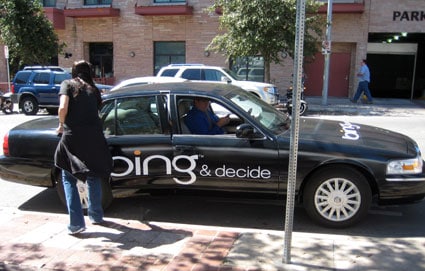As David Armano writes about SXSW “Hundreds of vendors, brands and companies vie for your attention.” This was certainly one of my big surprises from the recent SXSW event (my first time attending). From the huge attendee bag o’ crap with every kind of sticker, sample beverage, light-up pen, button, pamphlet, coupon, invite, brochure, and screen cleaner imaginable, to the half-dressed-skinny-girls inviting us to try a WiFi cafe, I was struck how by showing up in Austin I was essentially a captive audience to be marketed to. There was free food-and-drink (the Ice Cream Man on 6th street hands ice cream to passerby, with a Nokia napkin; the Sobe people were giving out psych-ward-meds-sized portions), free electricity (via Belkin and Chevy), and on and on.

Pepsi had large area with several zones, including tents for…I guess…video conferencing. I saw people hanging out at the bar drinking small portions of Pepsi, but not many making use of this service.

Bing had a fleet of Town Cars, as well as hostess-y types that would offer you a free ride.

This bus was promoting the new book from Tony Hsieh (of Zappos). I just saw it driving around, or worse, idling. I never saw anyone get on, or off. Was it an eco-nightmare billboard? Or some sort of service? I think it’s kind of creepy!

Sidewalk advertising, of course. Let’s hope they cleaned it up after, or that the city was prepared to fine them. I haven’t checked out this URL, but feel free to and let us know in the comments. Or, really, why bother?

There are three concurrent/adjacent festivals: Interactive, Film, and Music. Each of them serves up an insane range of options, well beyond what we normally encounter in our choice-flooded lives. The net effect (and my theme here) is that content creators are expected to shout louder (or more interestingly) to create awareness for their product. Here are ads for all sorts of things, including a cryptic phrase about a hurting vagina (which turned out to be from a movie).

Those posters don’t go up by themselves. It takes work.

As Austin reached beyond-critical-mass, 6th Street, the live music area, was closed to traffic. People were passing out more pamphlets and flyers promoting their events. And here’s where many of them ended up.

Just because.

Drawing attention to yourself to promote an event.

iPad guy was the triggering noticing event that led to this post. On my second-to-last night I saw this guy walk by, with a cardboard iPad around his neck (yes, kids, this was before the iPad was actually available). I yelled out “Hey, iPad guy!” and he stopped and let me take his picture. We introduced ourselves, and I asked him why he was wearing an iPad around his neck (see, that ethnography experience comes in handy!!!). His answer? So people will talk to him, like I did (turns out he works for a Search Engine Optimization firm, so…). While SXSW is a hyper-condensed environment, it represents some early-adopter aspects of typical daily life, and so I was struck to see the continuum between the promotion of Pepsi, Sobe, Bing, an indie film, an indie band, and an individual.
I’ve had my experience with guerrilla methods of promoting myself (from wearing a giant sombrero when campaigning for student government, with the slogan “the little guy in the big hat” to wearing a very loud SpiderMan tie when interviewing for jobs at a CHI conference long ago…only to be upstaged by the guy with a resume-dispensing-box with an embedded recording of him giving his elevator pitch) but the past seemed quainter, where the extreme needs (getting elected, getting a job) permitted extreme norms. But at SXSW it seems like everything is a promotion for something and I feel just a little bad seeing us take our lessons on how to connect with each other from big brands. Is this an exception or an emergent norm?
My favorite content from SXSW:
Check out more of my SXSW pictures here.
Slides and audio from Integrating User Insight, my presentation with Aviva Rosenstein, are here.
You may also like License to Shill, a FreshMeat column from 2004.










































